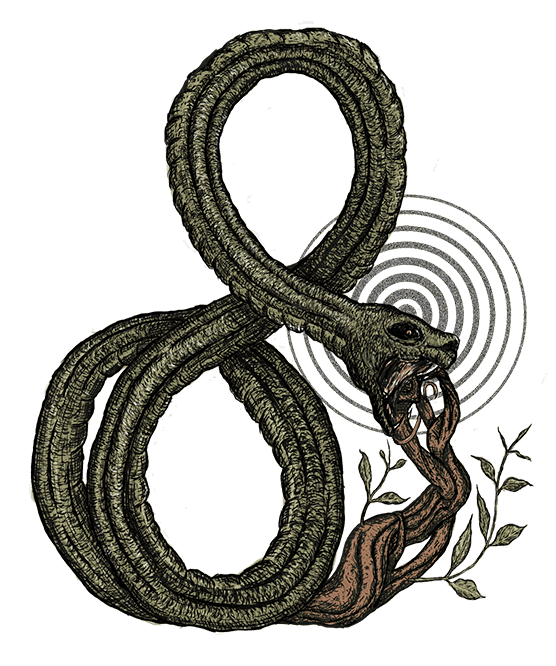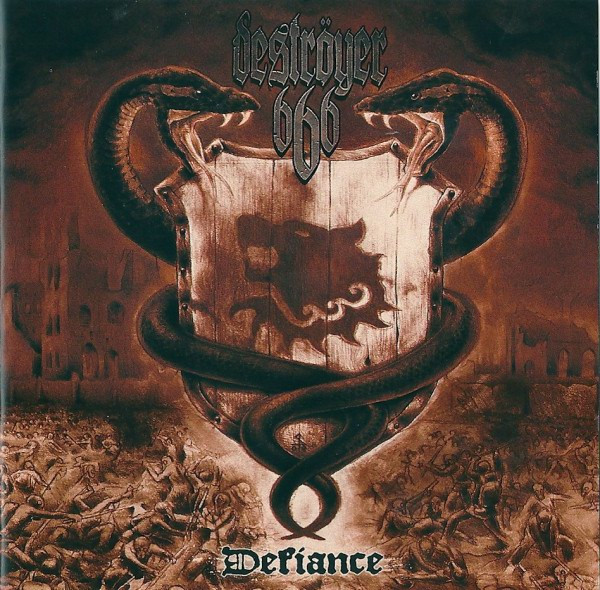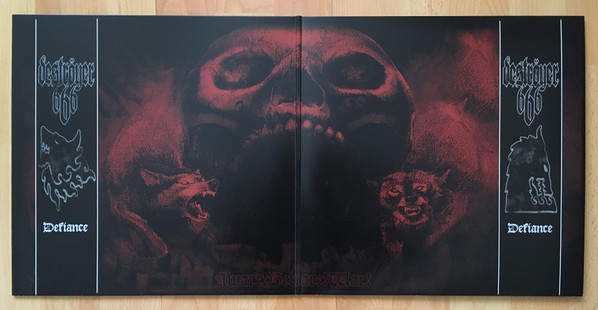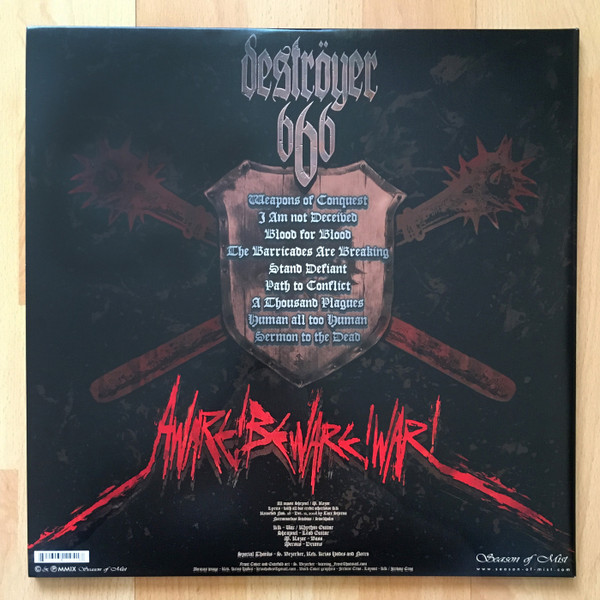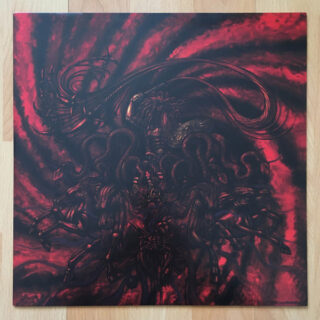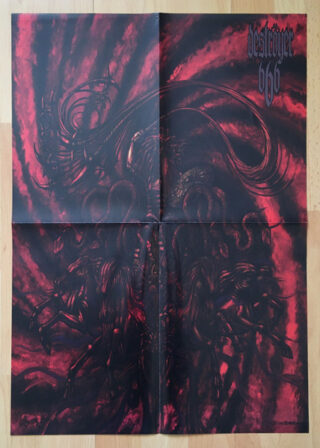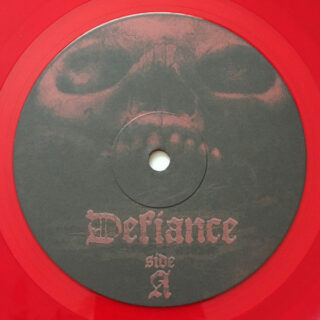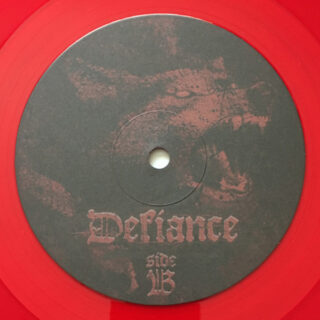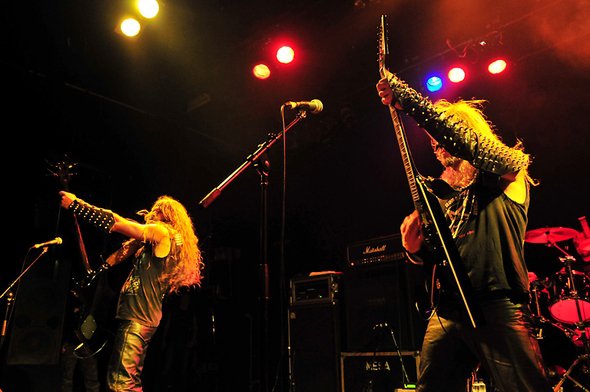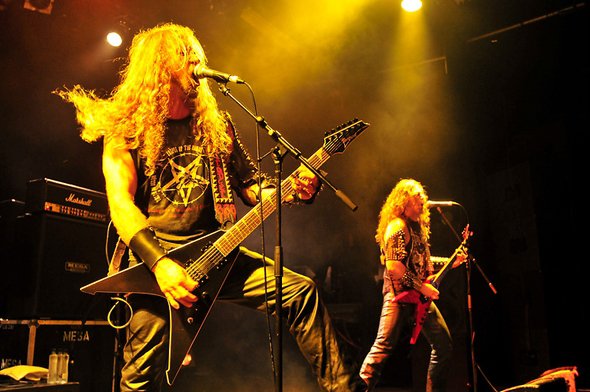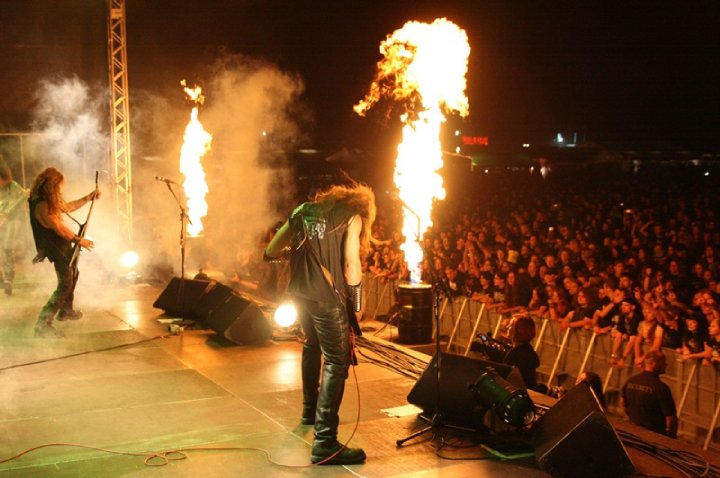Deströyer 666 VIII
2023-12-06
by Niklas Göransson
Scarred, but not beaten. After the longest creative drought of the band’s career, Deströyer 666 consolidated their forces and brought forth Defiance. In its wake, bedlam followed – both on and off stage – in the Americas and Australia.

IAN SHRAPNEL: In early 2008, I bought a twenty-four-track Tascam unit, which is a digital recording device – almost like a computer. It didn’t use tapes but had a disc drive and built-in fades and everything. Essentially, it was my attempt to push forward and keep the machine running. I wrote the riffs for what ended up as “Blood for Blood” and sent it to the others.
CHRIS MERSUS: Ian came over to Germany two weekends in a row, and we pieced together the song’s structure. Initially, he felt a bit unsure about the beat – whether it was too groovy or bouncy. We tried a few different drum patterns, but none of them really worked. I said, ‘This is just dull; we need something fresh.’ And that’s how we came up with what you can now hear in the song.
KK WARSLUT: I don’t recall being sent “Blood for Blood”, but Ian definitely got the ball rolling again. Him learning how to use recording software was a lifesaver, for sure, since he could now work on material at home instead of being confined to a rehearsal space. Credit to the man – otherwise, it would’ve taken us another five years.
MERSUS: Despite the lack of rehearsals, we managed to get several songs down on a demo. Matt and Ian really put a lot of effort into it; they pre-recorded the guitars in London and sent over the results for us to work with.
SHRAPNEL: Most of the music was written by Matt and me, that’s for sure. A few arrangements were made as a band, but… in the end, Keith struggled to find inspiration.
WARSLUT: I guess the short, easy answer is that my songs just weren’t finished. Since we rarely jammed together, it was difficult for me to flesh out any ideas I might’ve had. This was also around the time when I moved from Holland to Denmark.
SHRAPNEL: Both Matt and I lived in London, so we’d meet up and jam – but the band couldn’t gather more often than every six weeks or so. That’s part of the reason why it’s called “Defiance” – we had to defiantly overcome a lot of adversity.
Leading up to the new album, DESTRÖYER 666 re-signed with French label Season of Mist. With “Phoenix Rising” and then “Cold Steel… for an Iron Age”, their two-album deal had expired, following which they released the “Terror Abraxas” mini-CD on Iron Pegasus.
MICHAEL BERBERIAN: They wanted to do an EP somewhere else, and that’s fine; all good. I never had any doubt that they’d come back to us because Keith doesn’t trust anyone, really. The older he gets, the more paranoid he is – that’s a fact. Of course, they had offers thrown at them, left, right, and centre.
WARSLUT: Yeah, a few of the bigger labels came sniffing around. But like I said at the time, rather the devil you know.
BERBERIAN: He believes that better the devil you know than the one you don’t; I think that’s why DESTRÖYER always comes back to Season. In the end, there is mutual respect between us, so I wasn’t worried about them leaving.
DESTRÖYER 666 opted to record their fourth album at Necromorbus Studio in Stockholm. The producer, Tore Stjerna, came to prominence through his early 2000s work with Swedish bands such as FUNERAL MIST, WATAIN, MALIGN, OFERMOD, REPUGNANT, ARMAGEDDA, and many more.
MERSUS: By then, I’d recorded two different ZARATHUSTRA releases with Tore, and he did a tremendous job on both occasions. Necromorbus Studio was the perfect fit in every aspect: sound, vibe, and atmosphere. I thought we could get similar results with DESTRÖYER, and Tore seemed keen to work with us.
WARSLUT: We went there because of the great work Tore had done for ADORIOR on “Author of Incest”. But that was before he’d established his signature Necromorbus sound, and everything he recorded started sounding the same – just like Morrisound almost two decades earlier.
In November 2008, the recording of “Defiance” began with Mersus entering Necromorbus Studio – by himself.
MERSUS: That was definitely a first for me: being alone in the studio, drumming to a metronome while listening to scratch guitars. When recording the demo, we’d already set the tempos and created click-tracks for each song. It was bizarre, especially for someone like me who’s used to getting into the zone and feeling the vibe that comes from playing alongside other musicians.
WARSLUT: There’s a lot about the “Defiance” process that, in retrospect, was wrong. We thought the much colder, darker music lent itself to that approach, but of course, a big part of it was to save time. Any musician will tell you this – if the tempos vary, recording the guitars is much harder and more time-consuming. Using a click makes it a rather simple process; you just fly through ‘em.
MERSUS: The studio atmosphere was a bit weird. Tore isn’t the most talkative person, so the recording went by in relative silence. Whenever I stopped, he’d give me a quick nod, like, ‘Okay, you could do this differently, you shouldn’t do that’, and so on. He also suggested playing more like Lars Ulrich (METALLICA) – hitting the drums really hard. We tried out different things; Tore was very helpful, but I would’ve liked some feedback from my bandmates.
SHRAPNEL: To me, “Defiance” was a continuation of all the classic DESTRÖYER elements: a bit of everything. But it was a hard album to write because of the distance – and even though the songs were finished, we came to the studio under-prepared. In hindsight, that’s one of the problems I find with “Defiance”.
MERSUS: Looking back now, it’s clear to me that while “Defiance” is full of Ian’s fantastic melody lines, it suffers from the lack of Keith’s hooks. The true magic of DESTRÖYER lies in that combination.
WARSLUT: Absolutely, and that was as much my fault as anybody’s. Usually, I’d put forward my ideas for hooks at rehearsals, and then we’d work on them together. But because of our inability to jam, it just didn’t happen.
MERSUS: And, of course, Matt had a significant role in the songwriting this time. He’s a brilliant guitarist who leans heavily towards a mathematical and perfectionist approach to riffs, but that doesn’t always work for DESTRÖYER 666.
I can’t help but wonder what would’ve happened if KK had ‘mangled’ – as he himself put it – Matt Razor’s riffs to infuse them with his own characteristics. Like he did with Joe Skullfucker’s death metal riffing in BESTIAL WARLUST and Shrapnel’s “Lone Wolf Winter” riff on “Phoenix Rising”.
WARSLUT: Matt’s stuff is far too technical for that; it would’ve sounded horrible. The reason we don’t play those songs live is simply because I can’t. To me, when there’s a riff going on, it has a couple of recurring key chords. That is the tone: the essence of your riff. But listen carefully to what Matt does, and you’ll hear all this bullshit in between. I mean, maybe not bullshit – in terms of musicianship, it’s very accomplished – but trying to sing to that was fucked.
Do you think this contributed to the complaints that “Defiance” deviated from the DESTRÖYER style?
WARSLUT: Perhaps? I suppose that’s one of the downsides of not solely being a thrash, death, or black metal band. Then people know what to expect, and you can do the same thing with a slight variation on every album. “Defiance” certainly isn’t “Cold Steel…”, nor does it sound anything like “Unchain the Wolves”. Apart from maybe “Blood for Blood”, it’s a completely different beast.
“Defiance” sounds to me as if it rests on the same foundations as “Cold Steel…”, but with more death metal elements than thrash. Some of the material – “A Stand Defiant” comes to mind – wouldn’t have been out of place on “Phoenix Rising”. I think most of these ‘It doesn’t sound like DESTRÖYER’ sentiments stem from the production.
MERSUS: You are absolutely right – the sound really does something to it. Even Tore would probably agree. It lacks dynamics and energy, and that came down to him not wanting to stray from his comfort zone or change too much of the Necromorbus recipe.
WARSLUT: Mersus had just started studying to become an engineer, so I must admit, I figured he’d be our voice during the mixing. But I think a combination of him not feeling too confident in his skillset at the time and Tore being a quite domineering character in the studio made Chris take a step back. Like, ‘Oh, this guy knows what he’s doing.’
MERSUS: I could only be there for the first day of mixing before I had to fly back to Germany. After listening to the advance tracks, I was quite disappointed. I expressed my concerns to the guys and sent them a long list of things to change, but time was running out because they still had a couple of vocal tracks to record.
SHRAPNEL: Yeah, the sound is a major issue with “Defiance”. To be honest, I’m not sure how that happened. I wasn’t in the studio for the mixing, so I don’t really have any grounds to complain. Of course, I should’ve been there. But ultimately, I feel that the album didn’t quite get the production it deserved.
The ultra-compressed sound robs many individual components of their power and dynamic range, which affects the atmosphere in the epic parts. “Sermon to the Dead” is a fine example – it becomes a bit muddled in the crescendo with multiple vocal lines and guitar leads.
WARSLUT: Tore was compressing everything as he recorded it, which meant we’d long since crossed the point of reversal once the time came for mixing. And that kind of… I wouldn’t say ‘ruined’ because I know a lot of people love “Defiance”. But play it through a stereo, crank up the volume, and you’ll notice that it doesn’t get louder – like a good recording would – nor will it sound broader because everything is squished together.
SHRAPNEL: It truly is a curse how modern productions will compress the absolute fuck out of everything. It sounds impressive for about three seconds when it comes on – but once your ears adjust, there are no nuances or details. I don’t understand why people can’t just turn up the volume instead.
WARSLUT: Tore even told us why. Back then, metal magazines would often include compilation CDs – which actually seems kind of prehistoric now. Anyway, the labels wanted their bands to stand out, and your song will sound a bit louder if you brickwall the shit out of it. That was the prevailing reasoning, and I guess Tore was hoping to get an arrangement going with Season of Mist.
BERBERIAN: I doubt Tore did anything to please me. We work great together now but at the time, we neither collaborated nor communicated. Tore manages some of my bands, and I’ve learned to respect him – he did an amazing job for MAYHEM and WATAIN – but we had a complex relationship back then. I don’t think we liked each other that much. Me being really outgoing and him being very… Swedish. Also, Season of Mist took no part in the ‘compression war’. I’m a proper audiophile; my father owned a high-end Hi-Fi shop and was a sound engineer. I always prefer dynamics over compression, but it was the band’s decision.
Did you have any input on the mixing?
BERBERIAN: None whatsoever. I received “Defiance” as a finished product with the artwork and clear instructions: ‘Here, this is what you’re gonna release.’ ‘Okay.’ You know, I’m not in the studio telling the band how to play guitar or whatever. Unless I’m wanted, I never get involved in the production. And DESTRÖYER is not a band that asks anyone about anything. Their fucking art, their call. So yeah, “Defiance” is what it is. I had nothing to do with it.
SHRAPNEL: I remember being at a bar in London when I mentioned to someone that I had a promo of the new DESTRÖYER with me. He went, ‘Oh, can we put it on here?’ So, we listened to it through their massive PA, and it was like… ‘What the fuck?’ It sounded horrible. Now, I’m not entirely sure, but the vinyl version might’ve been remixed because it sounds a lot better.
MERSUS: It does; I can tell you that straight away. For the LP, we did both a remix and a remaster. We wanted to change the drum sound and bring back some dynamics – which meant putting in even more of our own time, effort, and money because the label didn’t wanna pay. They said, ‘Sorry guys, that’s it.’
WARSLUT: I kicked up a big fuss, so Tore redid as much as he could for the vinyl. I’m not sure to what extent it was remixed, but at least he got rid of some of the compression. After listening to it again now, I gotta say that “Defiance” isn’t as bad as I once thought. Because I really didn’t like it back then. But it was a time and a place – and apart from the production, I have no regrets.
MERSUS: A decade or so ago, I listened to “Defiance” – the LP mix – for the first time in a few years. Hearing it with fresh ears and trying not to be nostalgic, I found the songs absolutely killer with the different and much edgier sound. In terms of material, “Defiance” is a great album; no question about it.
Concept-wise, “Defiance” has more in common with the early material than “Cold Steel…”. It’s almost like a more down-to-earth version of “Unchain the Wolves” – philosophical but not pretentious by any stretch.
WARSLUT: I actually re-read those lyrics before the interview, trying to get my mind into that timeframe. I gotta say, I’m still very happy with them. Looking back, “Weapons of Conquest” looks like Matt’s writing – if not the entire thing, then at least the bulk of it. He also did some lines here and there, but the rest is all me.
SHRAPNEL: To some extent, Keith not having to worry so much about the music allowed him to dig deeper into the conceptual side of things, and that came out fucking amazing. His lyrics are the greatest aspect of “Defiance” – fantastic stuff.
WARSLUT: I tend to write lyrics that fit the music, and the “Defiance” riffs were – I guess, for lack of a better expression – darker and more serious sounding than usual. So yeah, me not having to work on the music and the riffs being a bit more sophisticated coalesced rather well.
The new album was promoted through a busy live schedule. One of the many important festivals DESTRÖYER 666 played in the summer of 2009 was Maryland Deathfest – their first US appearance in three years.
SHRAPNEL: Back then, many bands coming to the US didn’t have the correct visas; DESTRÖYER certainly didn’t. We used to bring next to no equipment and instead borrow or sometimes even buy gear there. So, it was a case of turning up at the airport trying not to look as if you were about to play a gig and then hoping the customs agent wasn’t interested in grilling you.
PESTILENCE found this out the hard way, as they got turned back by American customs. As a result, DESTRÖYER 666 were bumped up to co-headliners with BOLT THROWER.
MERSUS: Before we even went on, you could feel the energy surging from the crowd. They were going absolutely mental, unlike anything we’d witnessed before. And backstage, all eyes were upon us, which only added to the pressure. To top it off, Proscriptor from ABSU – one of my favourite drummers – kept staring at me. I finally told him, ‘Man, can you fucking stop? You’re making me nervous.’ Then he jumped up on stage and started fiddling around with the cymbal stands, helping me out.
SHRAPNEL: Sometimes when you get on stage, plug in your amp, and hit the first chord, it might sound a bit shit. Something’s cutting in and out, or the monitors aren’t working properly – and from that point on, it’s just an uphill battle, you know? But then there are times when everything sounds great straight off the bat, and those tend to be the best shows. This was one of them.
WARSLUT: From memory, our set got a really good response – almost to the point where we were a bit taken aback. Like, ‘Fucking hell, something must’ve happened here.’ Prior to this, we’d almost exclusively played tiny venues in the States.
DESTRÖYER 666 stayed active throughout the summer. I saw them at Sweden Rock Festival, Party San, and Festung Open Air. They also performed at Rock Hard Festival, Metal Magic, Hellfest, and so forth.
MERSUS: A couple of days before Rock Hard, I got a call from someone at the festival. I can’t remember his name now, but he told me that they might have to pull us from the bill. When I asked him why, he sent me the link to some German forum with a thirty-page discussion about DESTRÖYER being right-winged. And you could see a few… let’s say, dodgy photos of the demo booklet where they had discovered two swastikas.
WARSLUT: There are actually three swastikas on the demo – those commie idiots missed one. The cover artwork by (Australian occultist) Rosaleen Norton depicts a spiritual entity she called ‘Fohat’. Look closely, and you’ll see that he holds an inverted swastika, which represents the four seasons revolving around the central spirit. It’s all things at once, essentially. The reason I used it is because Fohat reminded me of the Jungian interpretation of Abraxas.
In Jungian psychology, Abraxas is a complex symbol that embodies both good and evil, transcending the duality of human moral positioning. The Abraxas figure comes from the Gnostic tradition, where it was seen as higher than the Christian God and Devil, combining both into one. Carl Jung adopted Abraxas to illustrate certain psychological concepts he was exploring – particularly the integration of opposites. The closing song on “Defiance”, “A Sermon to the Dead”, revolves around this concept. Furthermore, the LP version has artwork of Abraxas by Reverend Kriss Hades.
WARSLUT: Absolutely. Abraxas has been a recurring theme from the start of DESTRÖYER. The demo had Fohat, and in the bottom right corner of the reverse side of “Violence Is the Prince of This World”, you find Abraxas. And unless I’m mistaken, there’s also one on “Unchain the Wolves”. So, whenever I’ve used or referenced swastikas, it’s been as representations of Abraxas.
MERSUS: I asked the Rock Hard guy, ‘Seriously? Is this really happening?’ And then Party San also wanted to cancel us – all in the same week. Ultimately, Götz from Rock Hard stepped in and put an end to it. He made a statement in the forum, something like ‘DESTRÖYER 666 are playing, no matter what. I don’t give a fuck what the discussion is; I’ll support them one hundred per cent.’
log in to keep reading
The second half of this article is reserved for subscribers of the Bardo Methodology online archive. To keep reading, sign up or log in below.
